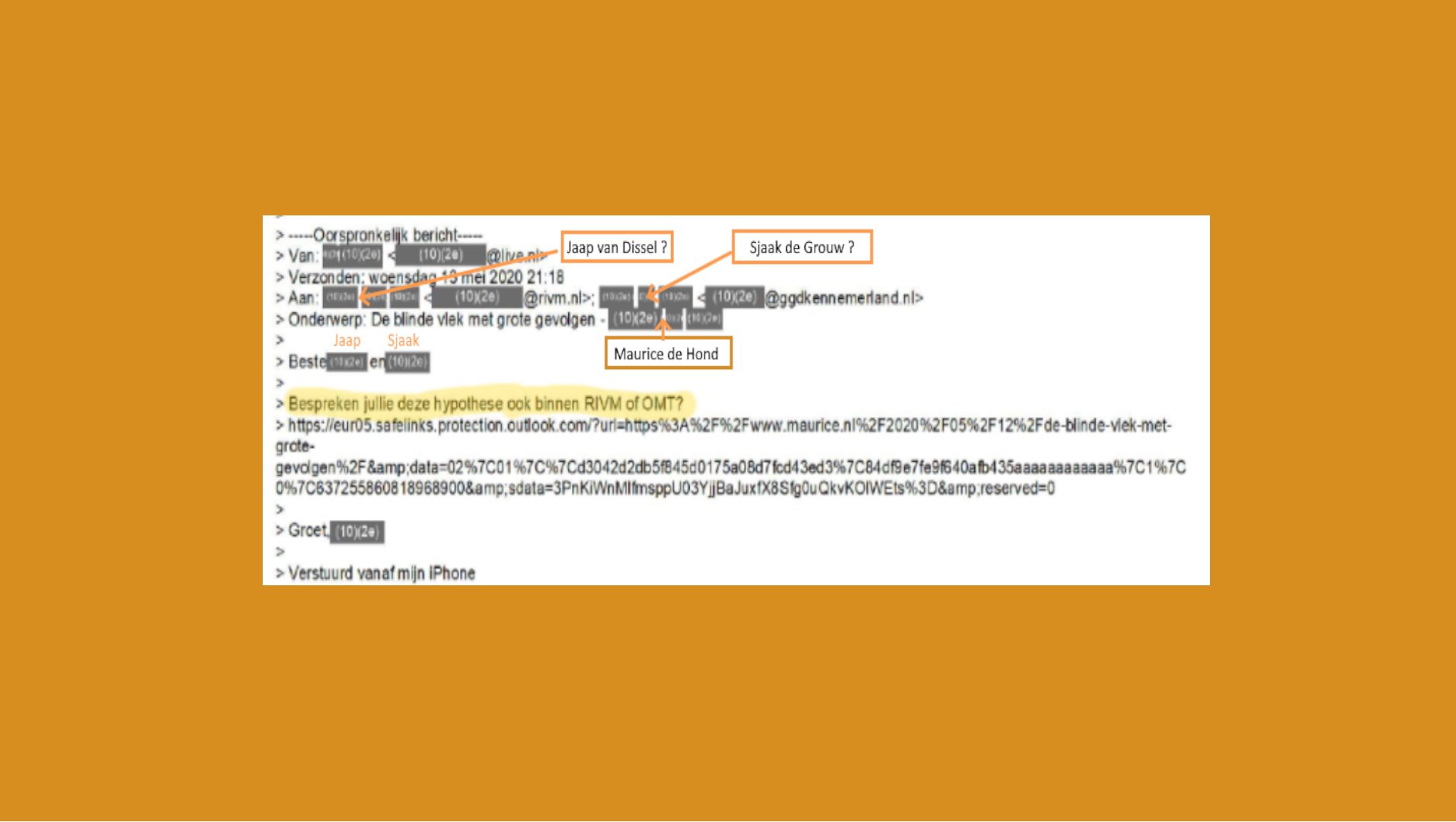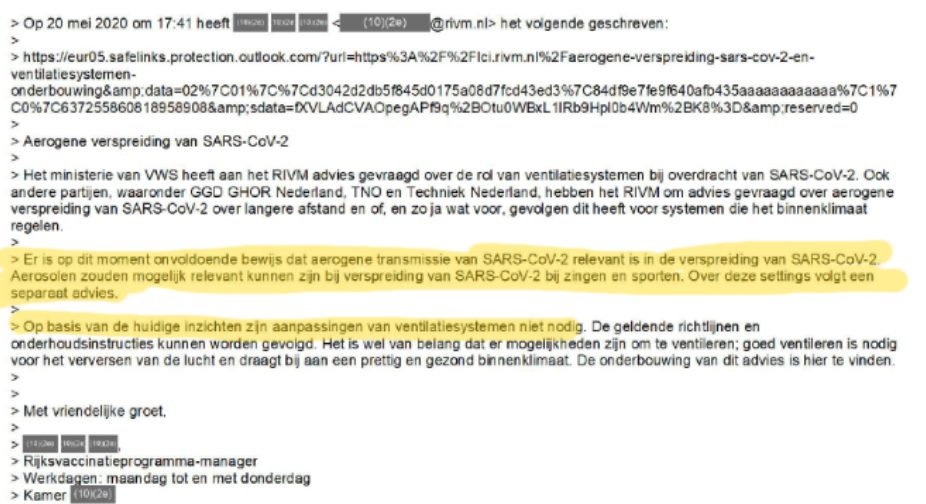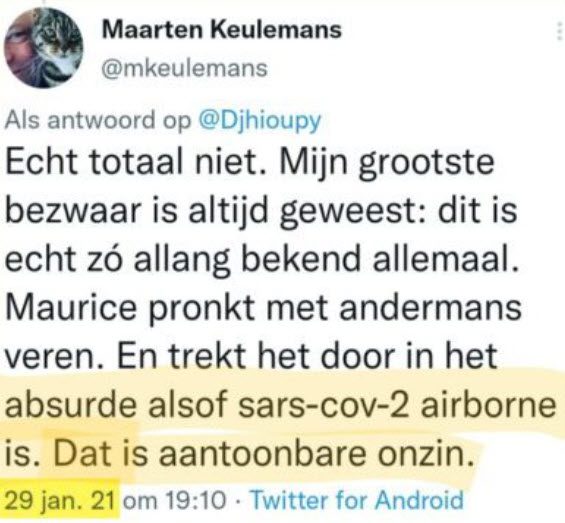
The WOB request shows a double blind spot in RIVM
Article summary
A WOB request showed that in May 2020, a minister or other senior politician asked the RIVM whether they were taking into account my evidence that the virus was airborne. But RIVM’s response showed that they did not respond to my content and merely repeated the doctrines of that moment. With dire consequences.
Read the full article: WOB demand shows a double blind spot in RIVM
reading time: 4 minutes
My article is in WOB request
From my direct contacts with various politicians/ministers, I learned that the articles on my site were also read by some of them in 2020. Also in May 2020, my evidence on airborne pollution was discussed during the Cabinet.
In practice, this was not noticeable and it was only in the second half of 2021 that the RIVM reluctantly took into account the possibility of aerosol spread (but a distance of 1.5 meters still had to be maintained and there was another lockdown).
The WOB request showed that a politician/minister asked the RIVM to respond in mid-May 2020 to an important article I wrote on 12 May 2020. The title of the article was “A blind spot with major consequences.”
In that article dated May 12, 2020, I assert, based on a number of scientific studies and data analysis, that in both influenza and COVID-19, the virus is transmitted through the air and infects people in this way. Not through large drops.
The article also states that precisely because of the insistence on “large droplets” as the source of influenza infection, a good explanation has never been found for why the virus spreads above 30 degrees north latitude in the fall/winter and in (Southeast Asia)-))) tropical regions not at all. This happens in the rainy season, especially during rain and thunderstorms.
At that time there was no outbreak in India, but I noted in the article that influenza spreads there during the monsoon, which lasts from June to October. And so it happened with Covid-19. It’s really worth re-reading this article. Because it shows how if you look at phenomena with an open mind and in a scientific way, you can find explanations. And that nothing like this happens if you rely, as the WHO, RIVM and members of the OMT do, on dogmas (“the virus spreads through large droplets”).
The end result of my article was:
This hypothesis about infecting another person via aerosol is much stronger than the one that the World Health Organization and others have worked on for years: that it roughly only happens within 1.5 metres. A hypothesis that provides an elegant and complete explanation for the long-sought holy grail of influenza research.
WOB document
The article was published on 12 May 2020, and on 13 May, a senior politician (I think I know who the Minister is) sent this email to the RIVM and GGD. He sent a link to my article and asked if they had also discussed this hypothesis within the RIVM or OMT.
A week later came this response:
Shortly afterwards, I heard from a Minister that my article was also a topic of discussion in the Cabinet in May 2020.
But although I had demonstrated in the May 12 article (as well as several articles before it) that the spread of the virus was through the air, with all its consequences, the RIVM and OMT took a dogmatic position.
The response did not discuss the content of my article(s) and what reasoning or reasoning error I had made, but they gave the answer they had kept for a long time.
The most terrible thing is that at that time I was classified as a “non-scientist,” and scholars did not have to humiliate themselves by arguing with me.
It would have made a big difference if it had been recognized in the summer of 2020 that the virus was transmitted through the air. It would have prevented many adverse effects of the measures and would have prevented many infections/injuries.
Appearance
Finally, I’ll finish with a big joke: Martin Keulmans also stated at the beginning of 2021 that Sars-cov-2 was not airborne at all (see tweet below with his usual disdain towards me).
I recently heard Martin now mention that later mutations of Sars-cov-2 have become airborne, but that was not the case with the original variant in 2020.
This is the sad level. I realize that in the article I wrote on May 12, 2020, the spread of the virus in 2020 was very similar to the spread of influenza. And that the virus also spreads through the air (that’s why influenza epidemics occur in our region in the fall/winter and around the equator during the rainy season). But by Colemans’ admission that he was clearly wrong earlier in this discussion with me, that certainly won’t happen.
The increased infectivity of later variants significantly reduced the amount of virus you could inhale before actually becoming infected. This means that in the first year, for example, you had to be in a room with the virus floating in the air for at least two hours before you became infected, and now it’s half an hour. (Although it should be noted that there is much greater immunity, which now plays an important role, which was not the case in 2020).
And one more observation (which is of course a one-off observation): In my not-so-large circle of acquaintances, I now know 4 people who have contracted Covid in the past two weeks. Two of them are almost certainly on a plane from Paris, and the others are in a car half an hour away with an infected person in England. All four had taken multiple Covid boosters and had also had Covid before.
Three out of four described it as a bad flu (with lots of headaches).

“Travel enthusiast. Alcohol lover. Friendly entrepreneur. Coffeeaholic. Award-winning writer.”


